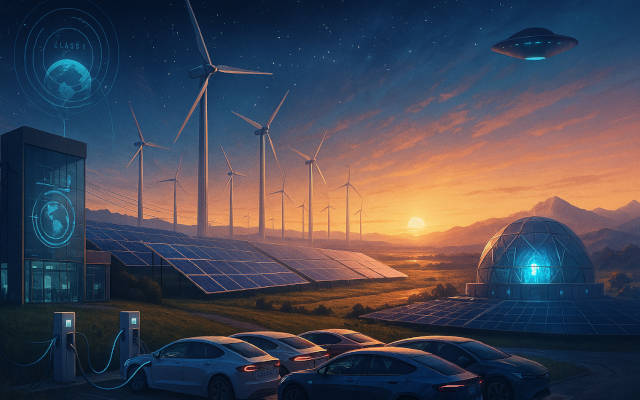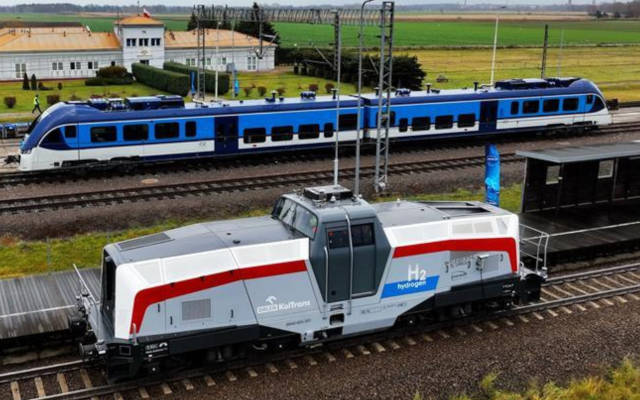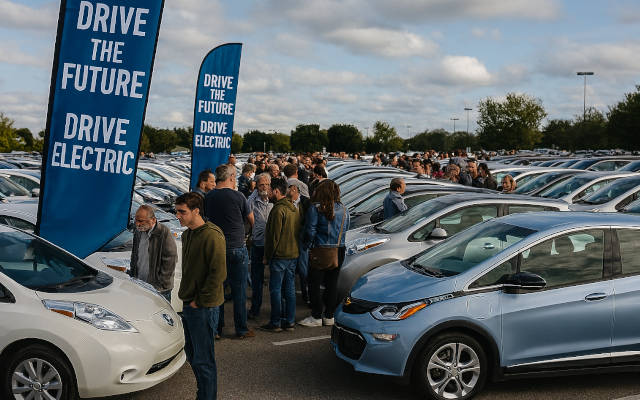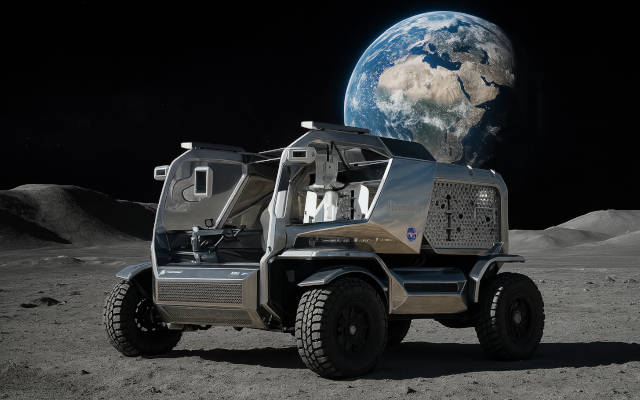 EDITOR'S PICK
EDITOR'S PICK
E1 Lagos Grand Prix: Where Speed Meets Sustainability on the Water
04 Oct 2025 | Synopsis
 The E1 Lagos Grand Prix electrified Africa's waterfront with high-speed, zero-emission RaceBirds reaching over 50 knots. Team AlUla, backed by LeBron James, claimed victory in a dramatic final heat, edging out Team Drogba and Team Miami. Uniform boat specs put pilot skill front and center, while Lagos showcased its commitment to clean marine innovation, making the event a thrilling blend of sport, sustainability, and spectacle.
The E1 Lagos Grand Prix electrified Africa's waterfront with high-speed, zero-emission RaceBirds reaching over 50 knots. Team AlUla, backed by LeBron James, claimed victory in a dramatic final heat, edging out Team Drogba and Team Miami. Uniform boat specs put pilot skill front and center, while Lagos showcased its commitment to clean marine innovation, making the event a thrilling blend of sport, sustainability, and spectacle.Let the Market Lead? Only If It Can See the Horizon
04 Oct 2025 | Synopsis
 The article challenges the WSJ's market-only energy stance, arguing that long-term resilience and sustainability must guide energy policy. It highlights the cost-effectiveness of renewables, the emerging role of EVs in grid stability, and speculative breakthroughs like fusion and UAP propulsion. Drawing from Native American philosophy and the Kardashev Scale, it calls for a seven-generations mindset to build a clean, reliable, and future-ready energy system.
The article challenges the WSJ's market-only energy stance, arguing that long-term resilience and sustainability must guide energy policy. It highlights the cost-effectiveness of renewables, the emerging role of EVs in grid stability, and speculative breakthroughs like fusion and UAP propulsion. Drawing from Native American philosophy and the Kardashev Scale, it calls for a seven-generations mindset to build a clean, reliable, and future-ready energy system.The Hydrogen Illusion: Poland's Fuel Cell Locomotive and the Uneven Future of Clean Rail
04 Oct 2025 | Synopsis
 Poland's hydrogen-powered SM42-6Dn locomotive marks a symbolic step toward clean rail, but hydrogen trains face steep economic and logistical hurdles. Germany's mixed results, including failures in the Taunus region, highlight infrastructure and reliability issues. Battery-electric trains offer higher efficiency and lower costs, while hydrogen remains a niche solution. Poland’s effort is strategic - more rehearsal than revolution - in a broader push for rail decarbonization.
Poland's hydrogen-powered SM42-6Dn locomotive marks a symbolic step toward clean rail, but hydrogen trains face steep economic and logistical hurdles. Germany's mixed results, including failures in the Taunus region, highlight infrastructure and reliability issues. Battery-electric trains offer higher efficiency and lower costs, while hydrogen remains a niche solution. Poland’s effort is strategic - more rehearsal than revolution - in a broader push for rail decarbonization.2026 Will Be The 'Year Of The Used EV,' Analyst Says. Here's Why
04 Oct 2025 | Synopsis
 Used EV prices are nearing parity with gas cars, boosting demand despite the end of federal tax credits. Analysts predict 2026 will be the “year of the used EV,” driven by affordability and a surge in lease returns. In August, used EV sales rose 59% year-over-year. Some models, like the Nissan Leaf and Chevy Bolt, are priced under $15,000. State incentives and lower battery costs continue to support the market.
Used EV prices are nearing parity with gas cars, boosting demand despite the end of federal tax credits. Analysts predict 2026 will be the “year of the used EV,” driven by affordability and a surge in lease returns. In August, used EV sales rose 59% year-over-year. Some models, like the Nissan Leaf and Chevy Bolt, are priced under $15,000. State incentives and lower battery costs continue to support the market.NASA Moon Rover Project Pushes Extreme Battery Tech To Its Limits
03 Oct 2025 | Synopsis
 GM is adapting its EV battery tech for NASA's Lunar Terrain Vehicle, part of Artemis V. Using durable lithium-ion packs with high-nickel NCMA cathodes, the rover will withstand extreme lunar conditions -temperatures from - 173°C to scorching highs - while operating reliably for 10 years. Four steerable wheels with crab-walk and zero-turn features boost mobility, and fault-tolerant design ensures function even if cells fail, extending U.S. exploration on the Moon.
GM is adapting its EV battery tech for NASA's Lunar Terrain Vehicle, part of Artemis V. Using durable lithium-ion packs with high-nickel NCMA cathodes, the rover will withstand extreme lunar conditions -temperatures from - 173°C to scorching highs - while operating reliably for 10 years. Four steerable wheels with crab-walk and zero-turn features boost mobility, and fault-tolerant design ensures function even if cells fail, extending U.S. exploration on the Moon.
 EVWorld Exclusive
EVWorld Exclusive
Can Food Waste Fuel America's Skies? The Promise And Pitfalls Of Trash-To-JetA
01 Nov 2025 |  Scientists are developing ways to turn America's massive food waste stream into sustainable aviation fuel. Using processes like hydrothermal liquefaction, discarded scraps can be converted into biocrude and refined into jet-ready fuel. At full scale, it could replace only a fraction of U.S. daily jet fuel demand, but it would cut landfill methane and diversify supply. Major hurdles remain: costly collection, dispersed feedstock, certification, and economics compared to fossil fuel.
Scientists are developing ways to turn America's massive food waste stream into sustainable aviation fuel. Using processes like hydrothermal liquefaction, discarded scraps can be converted into biocrude and refined into jet-ready fuel. At full scale, it could replace only a fraction of U.S. daily jet fuel demand, but it would cut landfill methane and diversify supply. Major hurdles remain: costly collection, dispersed feedstock, certification, and economics compared to fossil fuel.
Can Coal Power the AI Boom? Wyoming's Bet on a Fading Fuel
01 Nov 2025 |  Wyoming's coal is being promoted as vital for powering the AI boom, but the market reality tells another story. Utilities continue retiring coal plants as cheaper wind, solar, and natural gas dominate. Lease auctions draw little interest, and even China is pairing coal with massive renewable growth. Analysts warn AI demand may be overstated, leaving coal an expensive detour. The conclusion: coal is unlikely to fuel America's AI future.
Wyoming's coal is being promoted as vital for powering the AI boom, but the market reality tells another story. Utilities continue retiring coal plants as cheaper wind, solar, and natural gas dominate. Lease auctions draw little interest, and even China is pairing coal with massive renewable growth. Analysts warn AI demand may be overstated, leaving coal an expensive detour. The conclusion: coal is unlikely to fuel America's AI future.
America's Untapped Power: Why Wave Energy Still Waits For Its Moment
01 Nov 2025 |  America's waves hold vast untapped energy - enough to power over half the nation's electricity needs. Yet wave power lags behind solar and wind. Devices must survive corrosive seas and violent storms, while no single design has emerged as dominant. Developers also face years of regulatory hurdles and high costs that deter investors. New test sites like Oregon's PacWave aim to prove the technology, offering hope that wave energy can finally move from promise to reality.
America's waves hold vast untapped energy - enough to power over half the nation's electricity needs. Yet wave power lags behind solar and wind. Devices must survive corrosive seas and violent storms, while no single design has emerged as dominant. Developers also face years of regulatory hurdles and high costs that deter investors. New test sites like Oregon's PacWave aim to prove the technology, offering hope that wave energy can finally move from promise to reality.
Battle of the Boxes: Tokyo's Compact EV Showdown
30 Oct 2025 |  Three boxy EVs - BYD Racco, Nissan Sakura, and Honda Super-One - dominated the 2025 Tokyo Auto Show, each embracing Japan's kei car tradition with electric innovation. BYD eyes global markets, while Sakura and Super-One remain Japan-focused. U.S. entry would require upgrades in safety, speed, and tech. Their compact charm and urban utility signal a strategic shift in EV design - away from sleek sameness and toward character-driven mobility.
Three boxy EVs - BYD Racco, Nissan Sakura, and Honda Super-One - dominated the 2025 Tokyo Auto Show, each embracing Japan's kei car tradition with electric innovation. BYD eyes global markets, while Sakura and Super-One remain Japan-focused. U.S. entry would require upgrades in safety, speed, and tech. Their compact charm and urban utility signal a strategic shift in EV design - away from sleek sameness and toward character-driven mobility.
Why EVs Need Psychology More Than Horsepower
30 Oct 2025 |  Rory Sutherland argues that behavioral science is key to EV adoption. In the Everything Electric podcast with Imogen Bhogal, he explains that range anxiety is psychological, not technical, and that emotional reassurance matters more than battery size. He advocates for longer test drives, intuitive design, and incentives that reflect real human behavior. The interview challenges engineering-first thinking and urges empathy-driven policy to accelerate the EV transition.
Rory Sutherland argues that behavioral science is key to EV adoption. In the Everything Electric podcast with Imogen Bhogal, he explains that range anxiety is psychological, not technical, and that emotional reassurance matters more than battery size. He advocates for longer test drives, intuitive design, and incentives that reflect real human behavior. The interview challenges engineering-first thinking and urges empathy-driven policy to accelerate the EV transition.
 01 Nov 2025 15:37:36 UTC |
RECENT PODCASTS
Tesla RoboTaxis Crash More Than Waymo - 35,000 Rivian Amazon Vans
SEARCH RSSTREAM
 61 New Postings In Past 24 Hours
61 New Postings In Past 24 Hours
Category:mobility
Region:AsiaPacific
Date:01 Nov 2025
Category:finance
Region:Global
Date:01 Nov 2025
Category:policy
Region:NoAmerica
Date:01 Nov 2025
Category:energy
Region:NoAmerica
Date:01 Nov 2025
Category:energy
Region:NoAmerica
Date:01 Nov 2025
Category:policy
Region:Europe
Date:01 Nov 2025
Category:policy
Region:NoAmerica
Date:01 Nov 2025
Category:policy
Region:NoAmerica
Date:01 Nov 2025
Category:energy
Region:NoAmerica
Date:01 Nov 2025
Category:mobility
Region:Europe
Date:01 Nov 2025
Category:energy
Region:NoAmerica
Date:01 Nov 2025
Category:energy
Region:Global
Date:01 Nov 2025
Category:energy
Region:Global
Date:01 Nov 2025
Category:energy
Region:NoAmerica
Date:01 Nov 2025
Category:policy
Region:NoAmerica
Date:01 Nov 2025
Category:mobility
Region:AsiaPacific
Date:01 Nov 2025
Category:mobility
Region:NoAmerica
Date:01 Nov 2025
Category:mobility
Region:AustralPacific
Date:31 Oct 2025
Category:mobility
Region:NoAmerica
Date:31 Oct 2025
Category:autonomy
Region:NoAmerica
Date:31 Oct 2025